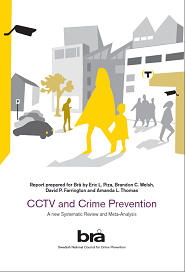- Start
- / Home
- / Publications

CCTV and Crime Prevention
A new Systematic Review and Meta-Analysis
This systematic review examines the best available research up to this point to answer the question: does CCTV prevent crime?
Closed circuit television surveillance (CCVT) is a commonly used and equally commonly debated method for preventing crime. Technological developments have contributed to a constant growth in the use of CCTV, and the body of research on the effects is also expanding.This systematic review examines the best available research up to this point to answer the question: does CCTV prevent crime?
There are never sufficient resources to conduct rigorous evaluations of all the crime prevention measures employed in an individual country such as Sweden. Nor are there resources to conduct scientific studies of all of the possible effects produced by different measures against crime and unsafety. For these reasons, the Swedish National Council for Crime Prevention (Brå) has commissioned distinguished researchers to conduct a series of international reviews of the research published in these fields.
In 2007 Brå published a systematic review on the effects of CCTV,based on 44 studies which at that time were available and efficient enough to be included. This report comprises an updated review, witch now includes a total of 80 studies. In focus are the effects of CCTV on levels of crime. The work has been conducted by Professor Eric L. Piza at John Jay College of Criminal Justice, (USA), Professor Brandon C. Welsh at Northeastern University (USA), Professor David P. Farrington at the University of Cambridge (UK), and Amanda L. Thomas at John Jay College of Criminal Justice (USA).
The study follows the rigorous methodological requirements of a systematic review and statistical meta-analysis. The analysis combines the results from a substantial number of studies that are considered to satisfy a list of empirical criteria for measuring the effects as reliably as possible. Even though important questions remain unanswered, the study provides a vital and far-reaching overview to date of the preventive effects of CCTV.
© The Swedish National Council for Crime Prevention, 2018
Authors: Eric L. Piza, Brandon C. Welsh, David P. Farrington, Amanda L. Thomas
urn:nbn:se:bra-774

